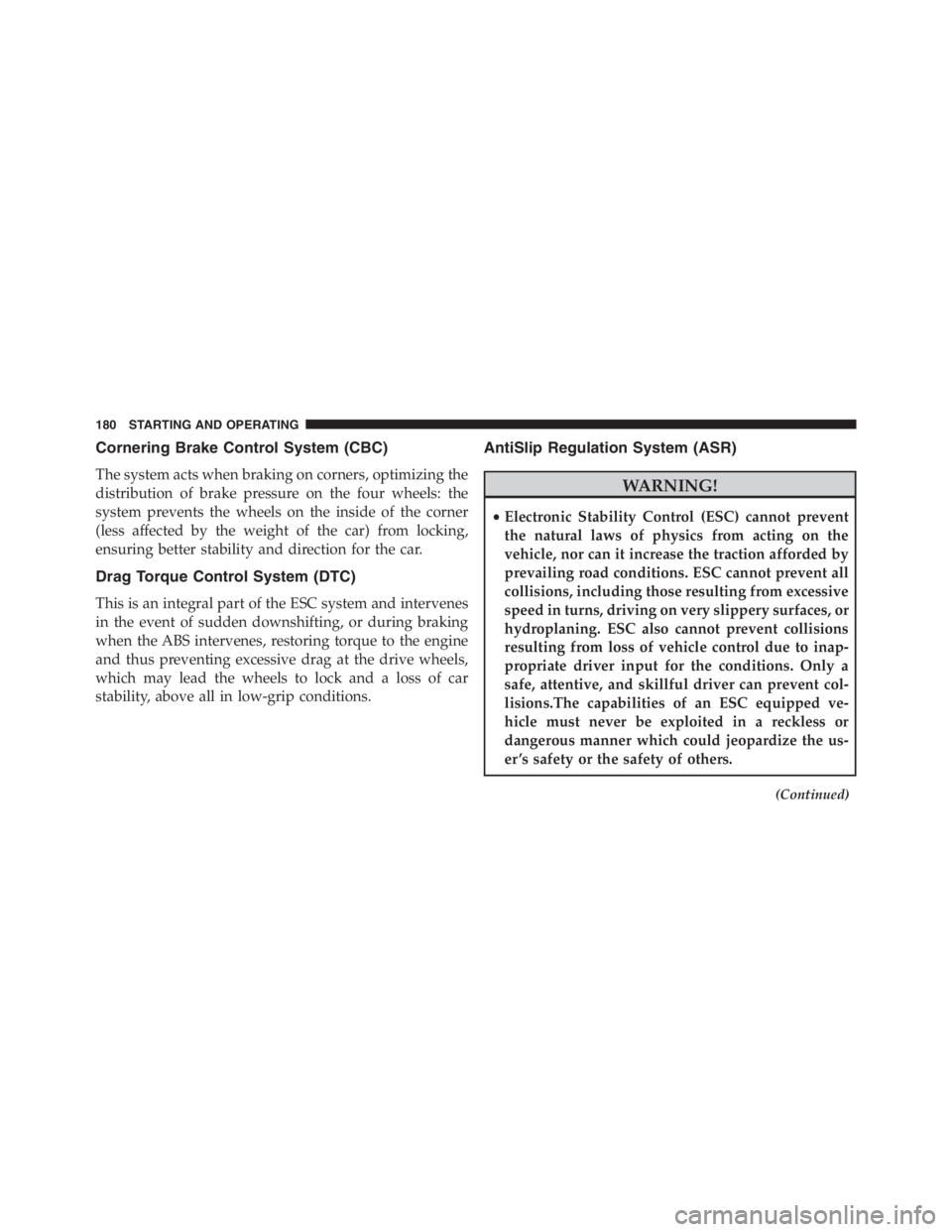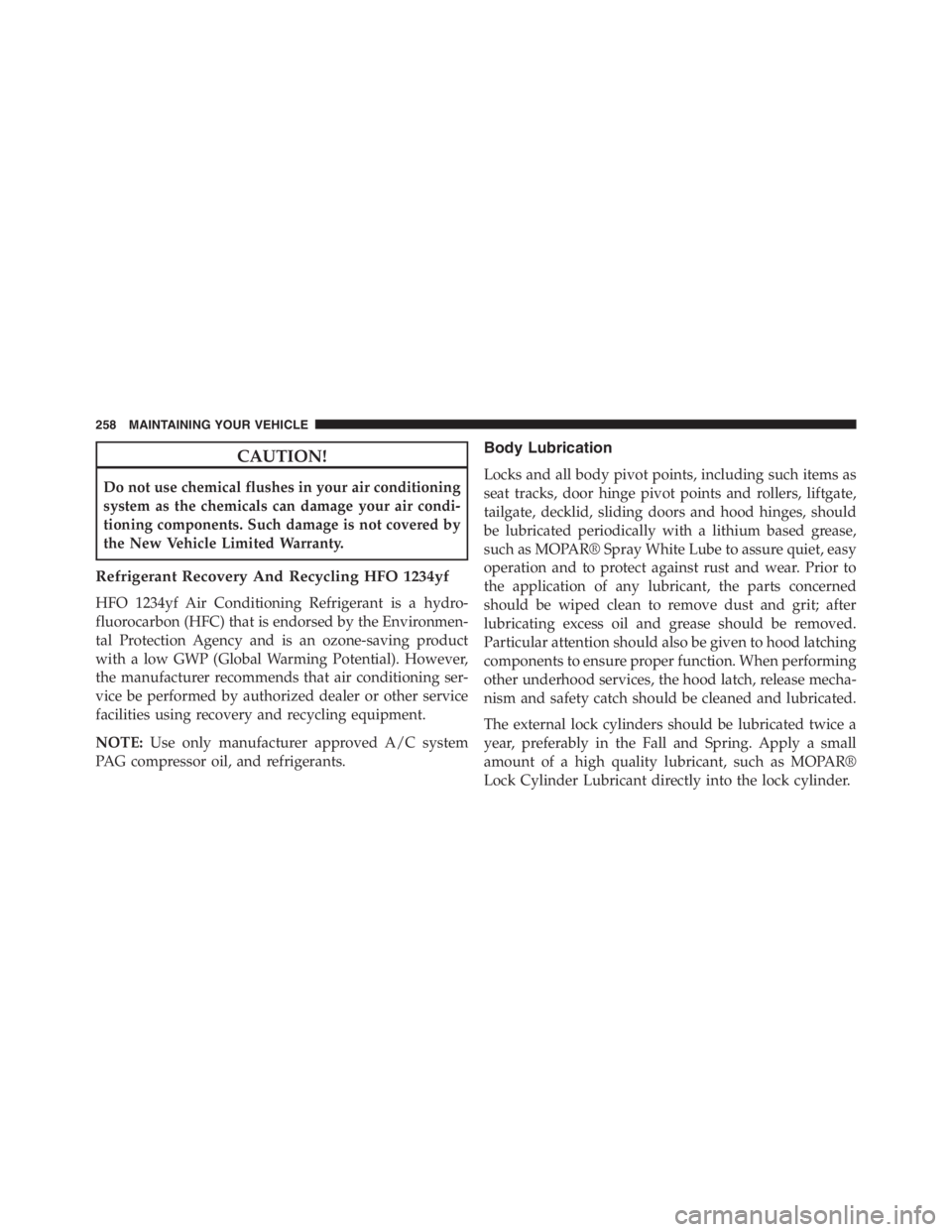Page 180 of 348

This guarantees greater braking stability for the vehicle,
preventing sudden locking of the rear wheels and the
consequent instability of the vehicle.
Four-Wheel Anti-Lock Brake System (ABS)
The Four-Wheel ABS is designed to aid the driver in
maintaining vehicle control under adverse braking con-
ditions. The system operates with a separate computer to
modulate hydraulic pressure, to prevent wheel lock-up
and to help avoid skidding on slippery surfaces.
The system’s pump motor runs during an ABS stop to
provide regulated hydraulic pressure. The pump motor
makes a low humming noise during operation, which is
normal.
The ABS includes an amber ABS Warning Light. When
the light is illuminated, the ABS is not functioning. The
system reverts to standard non-anti-lock brakes. Turningthe ignition Off and On again may reset the ABS if the
fault detected was only momentary.
WARNING!
•When the ABS intervenes and you feel the brake
pedal pulsating, do not reduce the pressure, but
hold it down firmly and confidently; in doing so
you will brake in the shortest distance possible,
depending on the current road conditions.
•For maximum efficiency of the braking system, a
bedding-in period of about 311 miles (500 km) is
required: during this period it is advisable to avoid
sharp, repeated and prolonged braking.
•If the ABS intervenes, this indicates that the grip of
the tires on the road is nearing its limit: you must
slow down to a speed compatible with the avail-
able grip.
(Continued)
178 STARTING AND OPERATING
Page 182 of 348

Cornering Brake Control System (CBC)
The system acts when braking on corners, optimizing the
distribution of brake pressure on the four wheels: the
system prevents the wheels on the inside of the corner
(less affected by the weight of the car) from locking,
ensuring better stability and direction for the car.
Drag Torque Control System (DTC)
This is an integral part of the ESC system and intervenes
in the event of sudden downshifting, or during braking
when the ABS intervenes, restoring torque to the engine
and thus preventing excessive drag at the drive wheels,
which may lead the wheels to lock and a loss of car
stability, above all in low-grip conditions.
AntiSlip Regulation System (ASR)
WARNING!
•Electronic Stability Control (ESC) cannot prevent
the natural laws of physics from acting on the
vehicle, nor can it increase the traction afforded by
prevailing road conditions. ESC cannot prevent all
collisions, including those resulting from excessive
speed in turns, driving on very slippery surfaces, or
hydroplaning. ESC also cannot prevent collisions
resulting from loss of vehicle control due to inap-
propriate driver input for the conditions. Only a
safe, attentive, and skillful driver can prevent col-
lisions.The capabilities of an ESC equipped ve-
hicle must never be exploited in a reckless or
dangerous manner which could jeopardize the us-
er ’s safety or the safety of others.
(Continued)
180 STARTING AND OPERATING
Page 242 of 348

WARNING!
Fast spinning tires can be dangerous. Forces gener-
ated by excessive wheel speeds may cause damage, or
even failure, of the axle and tires. A tire could
explode and injure someone. Do not spin your vehi-
cle’s wheels faster than 30 mph (48 km/h) or for
longer than 30 seconds continuously without stop-
ping when you are stuck and do not let anyone near
a spinning wheel, no matter what the speed.
ENHANCED ACCIDENT RESPONSE SYSTEM
In the event of an impact, if the communication network
remains intact, and the power remains intact, depending
on the nature of the event the ORC will determine
whether to have the Enhanced Accident Response Sys-
tem perform the following functions:
•Cut off fuel to the engine.•Flash hazard lights as long as the battery has power or
until the ignition key is turned off.
•Turn on the interior lights, which remain on as long as
the battery has power or until the ignition key is
removed.
•Unlock the doors automatically.
After the event occurs, when the system is active, in
addition to the message Fuel Cutoff See Handbook, a
specific soft telltale is displayed.
Carefully check the vehicle for fuel leaks in the engine
compartment and on the ground near the engine com-
partment and fuel tank before resetting the system and
starting the engine.
System Reset Procedure
Depending on the nature of the event the left and right
turn signal lights, located in the instrument panel cluster,
240 WHAT TO DO IN EMERGENCIES
Page 260 of 348

CAUTION!
Do not use chemical flushes in your air conditioning
system as the chemicals can damage your air condi-
tioning components. Such damage is not covered by
the New Vehicle Limited Warranty.
Refrigerant Recovery And Recycling HFO 1234yf
HFO 1234yf Air Conditioning Refrigerant is a hydro-
fluorocarbon (HFC) that is endorsed by the Environmen-
tal Protection Agency and is an ozone-saving product
with a low GWP (Global Warming Potential). However,
the manufacturer recommends that air conditioning ser-
vice be performed by authorized dealer or other service
facilities using recovery and recycling equipment.
NOTE:Use only manufacturer approved A/C system
PAG compressor oil, and refrigerants.
Body Lubrication
Locks and all body pivot points, including such items as
seat tracks, door hinge pivot points and rollers, liftgate,
tailgate, decklid, sliding doors and hood hinges, should
be lubricated periodically with a lithium based grease,
such as MOPAR® Spray White Lube to assure quiet, easy
operation and to protect against rust and wear. Prior to
the application of any lubricant, the parts concerned
should be wiped clean to remove dust and grit; after
lubricating excess oil and grease should be removed.
Particular attention should also be given to hood latching
components to ensure proper function. When performing
other underhood services, the hood latch, release mecha-
nism and safety catch should be cleaned and lubricated.
The external lock cylinders should be lubricated twice a
year, preferably in the Fall and Spring. Apply a small
amount of a high quality lubricant, such as MOPAR®
Lock Cylinder Lubricant directly into the lock cylinder.
258 MAINTAINING YOUR VEHICLE
Page 263 of 348
3. Push the wiper blade up the and remove it. 4. Install the wiper blade and firmly press the wiper
blade until it snaps into place.
Windshield Washer Nozzles
The windshield washer nozzles are adjustable. They
originally adjusted at the factory. Should it be necessary
to adjust them again, contact your authorized Alfa Ro-
meo Dealer.
If there is not jet of fluid, first check that there is fluid in
the washer reservoir. Refer to “Adding Washer Solvent”
in this section for further information.
Then check that the nozzle holes are not clogged; use a
suitable tool such as a needle to unblock them if neces-
sary.
1—WiperBlade
2 — Release Button
3—WiperArm
7
MAINTAINING YOUR VEHICLE 261
Page 291 of 348
Cavity Maxi Fuse Mini Fuse Description
F01 70 Amp Tan Body Controller
F03 20 Amp Yellow Ignition Switch
F04 40 Amp Orange Anti-Lock Brake Pump
F05 20 Amp Yellow Anti-Lock Brake Valve
F06 40 Amp Orange Radiator Fan - Low Speed
F07 50 Amp Red Radiator Fan - High Speed
F08 20 Amp Yellow Blower Motor
F09 5 Amp Tan Headlight beam switch (If Equipped)
F10 10 Amp Red Horn
F11 20 Amp Yellow Powertrain
F14 15 Amp Blue Alfa Twin Clutch Transmission
F15 15 Amp Blue Alfa Twin Clutch Transmission
F16 5 Amp Tan Alfa Twin Clutch Transmission, ECM
F17 10 Amp Red Powertrain
F18 5 Amp Tan Powertrain
7
MAINTAINING YOUR VEHICLE 289
Page 292 of 348
Cavity Maxi Fuse Mini Fuse Description
F19 7.5 Amp Brown Air Conditioning Compressor
F21 20 Amp Yellow Fuel Pump
F22 20 Amp Yellow Engine Control Unit Power Supply
F24 5 Amp Tan Anti-Lock Brake System (ABS)
F30 10 Amp Red Water Pump, HVAC
F82 30 Amp Green Headlamp Washer (If Equipped)
F83 40 Amp Orange Alfa Twin Clutch Transmission Pump
F84 5 Amp Tan After Run Pump
F86 15 Amp Blue Rear Power Outlet 12V
F88 7.5 Amp Brown Heated Mirrors
Dashboard Fuse Box
The dashboard fuse box is part of the Body Control
Module (BCM) and is located on the passenger side
under the forward passenger floor. Remove the six
screws and the forward floor pan to access the BCM.
290 MAINTAINING YOUR VEHICLE
Page 293 of 348
CavityVehicle Fuse
NumberMini Fuse Description
3 F53 7.5 Amp Brown Instrument Panel Node
4 F38 15 Amp Blue Central Door Locking
5 F36 10 Amp Red Diagnostic Socket, Car Radio, TPMS, Alarm
6 F43 20 Amp Yellow Bi-Directional Washer
7 F48 20 Amp Yellow Passenger Power Window
9 F50 7.5 Amp Brown Airbag
10 F51 7.5 Amp Brown Headlamp Washer Relay, A/C Compressor Relay,
High Beam Relay, Parking ECU, Car Radio, Stop
Lamp Switch
11 F37 7.5 Amp Brown Stop Light Switch, Instrument Panel Node
12 F49 5 Amp Tan Transmission Shifter Module, Cigar Lighter Light,
Drive Style Unit, Heated Mirrors Relay
13 F31 5 Amp Tan Climate Control, Body Controller
14 F47 20 Amp Yellow Driver Power Window
7
MAINTAINING YOUR VEHICLE 291